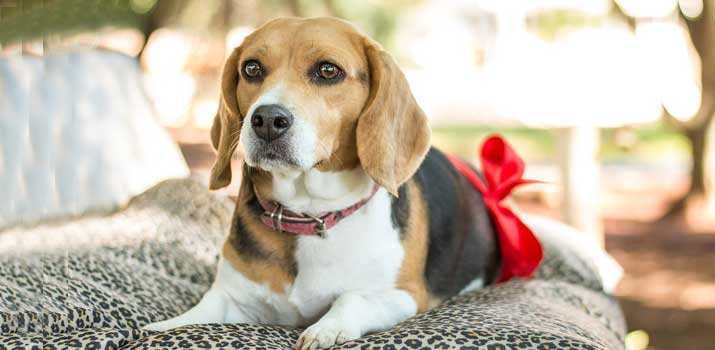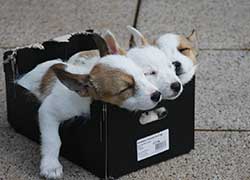Caring for a pregnant dog can be a very rewarding experience. You get to witness the miracle of life and watch your canine companion go through the joys of motherhood. Plus, you’ll be welcoming a bundle of playful puppies into the world.
But just how many pups will your dog give birth to?

This is one of the most common questions that owners of pregnant dogs have. Once the excitement of the pregnancy starts to dwindle, the realities of having to prepare for the arrival of puppies will kick in.
Caring for newborn puppies requires ample supplies, so it’s important to get a general idea of what to expect.
Unfortunately, there’s no way to know for sure in the early stages of your dog’s pregnancy.
Only an X-ray will be able to confirm this information. However, it can only be performed by your vet a few weeks before birth.
Luckily, hundreds of years of breeding and plenty of scientific studies have given us humans more insight into the canine reproductive process.
There are a few ways to estimate how many puppies a dog is capable of having.
While it’s not an exact science, the information below can be used to get a general idea.
Understanding the Canine Pregnancy Cycle
First, let’s dive a bit deeper into the pregnancy cycle. If this is your dog’s first time having pups, it’s important to know what to expect.
After conception, your furry friend is going to go through some major changes in only a short amount of time. The pregnancy cycle is significantly shorter for canines than it is for humans.
Pregnancies only last between 58 and 68 days. So, you only have about two months to prepare for birth.
Sexual Maturity and the Heat Cycle
Dogs reach sexual maturity relatively early. For most breeds, this occurs at about six months of age. Though, various factors can lead to some variation.
Smaller breeds are capable of reaching maturity at only four months of age.
After this point, female dogs go through periods of being “in heat.” Essentially, this means that your dog’s body is primed for having pups. They are the most fertile during this time.
The length of the heat season and how often it occurs varies from dog to dog. Though, female dogs are usually in heat every six months.
Around the 11th day of being in heat, ovulation occurs. This is when your pup’s eggs are released from their ovaries. During this time, there’s a much higher chance of conception.
Three Weeks Into the Pregnancy
During the first few weeks of pregnancy, you may not even know that your dog is carrying pups. As they’re developing, there aren’t too many symptoms that you can see. However, there’s a lot of hormonal changes happening within her body.
At 21 days, veterinarians can usually confirm a pregnancy. This is typically done through a blood test.
Ultrasounds may also be performed to see how they’re developing. However, you won’t be able to count how many offspring there are just yet.
One Month Into the Pregnancy
Once you hit the 30-day mark, your dog will start to exhibit some tell-tale signs.
One of the first things you’ll notice is vomiting. Morning sickness affects canines just as much as it does humans.
Your pup will feel ill and may start to show some behavioral changes. She will become lethargic and avoid her food for a bit. Usually, this passes in only a few days.
You may also notice some minor bodily changes.
Her teats may start to swell up as milk is being produced. The nipples may also start to produce a clear fluid as the milk ducts prepare themselves for feeding.
Also, it’s not uncommon to see some vaginal discharge.
40 Days Into the Pregnancy
At this point, it should be pretty obvious that your dog is pregnant. She’ll gain considerable weight and have a stronger appetite than before.
Depending on the number of pups she’s carrying, you may also be able to see the size of her abdomen increase a little bit.
This is most common with large dogs. In smaller dogs, the babies are so tiny that it often takes a bit longer for the mother to show.
45 Days Into the Pregnancy
With only a few weeks left until your dog gives birth, your vet will be able to perform an X-Ray. The puppies will be developed enough to see their bone structure.
Your vet will use this time to count how many pups there are.
They’ll also make note of how the pups are growing and check to see if there are any abnormalities.
See this video on the various stages of dog pregnancy
Birth
The birthing process can start as early as two days before the puppies actually come out.
The first sign that your dog is ready will be a change in behavior. She will start pacing around looking for a good spot to give birth.
This is called nesting. It’s common for mothers to claw at the ground in an attempt to make the birthing area as comfortable as possible.
Contractions will start to happen about 12 hours before delivery.
Many dogs will start shaking and panting heavily. She’s in a lot of pain, so she may also start vomiting or crying.
While it will be tempting to coddle your pregnant pooch, it’s best to give her space.
You can keep a watchful eye from a distance. She has everything she needs to deliver her babies. Her instincts will take over when she’s ready to push.
Average Breed Specific Litter Sizes
| Breed | First Litter | Later Litters |
|---|---|---|
| Pitbulls | 2 to 5 puppies | 7 to 10 puppies |
| Product Name | Feature Description | Here comes some text |
| Product Name | Feature Description | Here comes some text |
| Product Name | Feature Description | Here comes some text |
Factors That Determine Litter Size
There are a number of things that will influence your dog’s litter size. Some of the following factors are genetically predetermined while others relate more to lifestyle and health.
Breed and Size
One of the most influential factors is going to be your dog’s breed and size. Larger breeds almost always have more puppies than smaller ones.
The average puppy count for large dogs is 7 per litter.

For miniature breeds, it’s only 3.
Large dogs like Great Danes and Labradors are capable of having more than 10 puppies at one time.
Their bodies are simply better at handling the development of many pups.
Another thing to consider is your dog’s lineage.
Mixed breeds tend to have larger litters because their gene pool is more diverse. However, those that have been inbred to produce pups with certain traits tend to have fewer babies.
Method and Time of Conception
How your dog conceived can play a role in how many puppies she will have.
While most breeders have the experience to know when a dog is the most fertile, artificial insemination can result in fewer pups.
This is often due to how semen is preserved. The freezing process kills many of the sperm cells, which leads to a decrease in fertilization.
If your dog was impregnated naturally, there’s a higher chance that she’ll have more pups.
The exact date impregnation occurred is also important. Dogs are most fertile after ovulation because hormone levels are just right.
Many breeders have found that more pups are born if the dog gets pregnant 48 hours after ovulation.
Age
Contrary to popular belief, there’s no cutoff age when it comes to dogs getting pregnant.
They remain fertile well into their senior years. However, early adulthood is when they’re most likely to have a large litter.
Canines are most fertile between the ages of 2 and 5. Once they get older than that, litter sizes tend to decrease with subsequent pregnancies.
Number of Past Pregnancies
From a biological standpoint, most dogs are ready to have babies during their next heat cycle. Each time your dog gets pregnant, there’s a higher chance that she’ll have more pups.
This is typically seen with the third, fourth, and fifth pregnancy.
The main exception to that rule is the very first pregnancy.
The first litter is usually small. Not much is known about why this happens. However, many believe that it has to do with unfamiliarity.
Hormonal changes from anxiety and stress can affect how the eggs develop. Once your pooch knows what to expect during pregnancy, their anxiety won’t have as much of an effect.
Overall Health
Being pregnant is very taxing on your dog’s body. If they’re already not in the best shape, they aren’t going to have a large litter. Not only that, but poor health can lead to issues during the pregnancy.
It’s important that you keep your dog healthy throughout the process.
Diet
Diet and health are directly related.
Whether you feed your dog commercial kibble or homemade meals, the quality of their food can determine how many pups they have and how smooth the pregnancy is.
Your dog’s body requires a constant supply of nutrient-rich food to support the development of her babies. If she’s not getting enough fuel, the pups can die in the womb or come out prematurely.
Some breeders choose to make some changes to their dogs’ diet to maximize the litter size. They’ll often supplement the food with more protein.
The jury is still out on whether this is beneficial to pregnant dogs or not, so it’s best to consult with your vet before making any dietary changes.
Does the Sire Have an Effect?
It’s not just the traits of the female dog that are going to affect the litter size. The father also plays a role. However, it’s more limited.
Not only that, but many of the factors that come into play are not as easy to consider when you’re trying to figure out how many puppies will result from their conception.
Genetics and overall health affect how the sperm performs. But, it’s how the female’s body will react to their sperm that’s most important.
Can Dogs Have More Than One Litter in a Year?
Technically speaking, dogs are ready to get pregnant again during the next heat cycle after giving birth. Since most dogs go through heat twice a year, it’s perfectly possible for her to have two litters in a single year.
If your dog goes through heat more frequently, she may even be able to have three litters.
With that being said, there are many risks with multiple pregnancies in one year. Your girl’s body goes through a lot when she has babies. Not just during the pregnancy phase, but after birth as well.
She has to support those pups until they’re weaned off her milk.
Breeding a dog again before she has had the chance to recover fully is dangerous.
The dog needs to be in good health to produce a healthy litter, so many breeders choose to skip a breeding cycle after birth.
What to Expect After Birth

Once your dog gives birth, you need to provide a lot of support. Whether she has a small litter or a large one, those little pups are going to be a handful.
For the most part, your dog will know what to do. However, there are a few exceptions.
If this is your dog’s first pregnancy, you need to keep a watchful eye on her.
The first pregnancies are always the hardest for new canine mothers. She may have some problems caring for her babies, so you need to step in when it’s appropriate.
Make sure that the entire litter is getting access to food.
Some may have a hard time finding a nipple to feed on. This could lead to a quick decline in health and eventual death. Help the little pup latch on and eat.
You may also want to start thinking about the weaning process. Puppy milk and homemade slurries can help supplement the litter’s meals once your dog’s teats start to dry up.
In addition to making sure that the puppies are well-fed and warm, pay attention to the mother’s well-being. Some first-time moms don’t adapt to motherhood very well.
She can become stressed out and agitated. Keep her happy by giving her plenty of love, good food, and amply treats.
Conclusion
Having a general idea of how many pups you’ll be caring for can make the birthing process much easier. You’ll be able to plan ahead for the supplies you need.
It’s recommended that you seek help from your vet as soon as you suspect that your dog is pregnant.
They can provide you with guidance through this exciting time to ensure that your dog and her pups remain healthy..
Also Read: Best Rated Large Breed Puppy Foods

